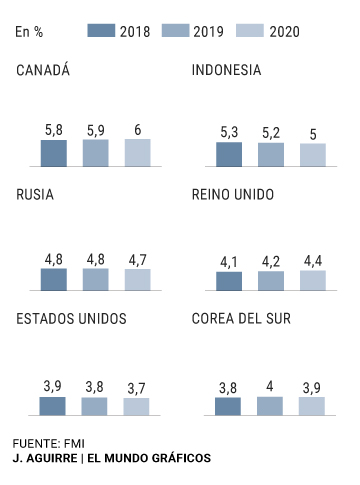- Labor: Unemployment drops by 4,253 people in July, but it does not break the 3 million unemployed barrier
- June data.The high season brings unemployment down to three million people and brings Social Security to its record
- Economy: Spain and Greece lead unemployment with rates that double the EU average
Spain is the economic power with the highest unemployment rate worldwide, doubling or even tripling the levels of other major economies. The latest figures offered by the International Monetary Fund (IMF) show this, but what is even more worrying is that both the IMF's own forecasts and the signs of exhaustion that the labor market is already beginning to offer threaten to perpetuate the Spanish economy in this worrying situation .
According to the Fund, the average Spanish unemployment rate in 2018 was 15.3%, a figure that only Brazil, Turkey and Italy approach, although in the case of the European country the difference is already five points. The rest of the large economies do not reach 10% unemployment in any case, and in Germany, Japan, Korea or the United Kingdom unemployment does not reach 5%, which makes 15% of Spain, if possible, more Blushing and alarming .
For this year, the average figure that the body still chaired by Christine Lagarde foresees for the Spanish economy is 14.2%, a rate that once again is well above that of the Netherlands, France, Russia or Mexico. And in 2020, the Fund estimates 14.1%, so obviously Spain will continue to maintain its position as the global power of unemployment .
These forecasts also mean that unemployment will hardly be reduced in the coming years, that job creation will be paralyzed. And that is precisely what could be beginning to show the labor market. After the economy showed its worst quarterly growth in five years between April and June, last Friday there was the lowest fall in unemployment during a month of July since 2008. It was a reduction of just 4,253 people, in a month in which The summer campaign always offers good figures, and with a global figure that still exceeds three million unemployed despite the fact that the acting president of the Government, Pedro Sánchez, advanced the opposite during his intervention in the failed investiture.
The Executive, however, has rejected on more than one occasion that there is a slowdown, and last Friday, in the press conference after the Council of Ministers, the Minister of Economy, Nadia Calviño, only acknowledged that there is a " Moderation " in growth and in the rate of unemployment reduction.
However, Calviño stressed that "it remains at a very important rate in interannual terms " and stressed that a good part of this situation is due to the increase in the active population.
Calviño has already questioned the Fund's ability to make a tight forecast when the IMF data was known. And the official forecast of the Government, as stated in the Budget Plan sent to Brussels, is that unemployment in the current year is reduced to 13.8% and that in 2020 it drops to 12.3%, which represents a substantial difference with respect to the estimate of the said organism.
In these same estimates, the Executive expects the unemployment rate to fall back to 11% in 2021 and fall to 9.9% in 2022. These figures may seem somewhat optimistic since they are not only better than those of the Fund, but which also exceed those of the Bank of Spain. The regulator led by Pablo Hernández de Cos expects unemployment to be at 12.4% next year and at 11.8% in 2021, so it seems difficult for unemployment to be less than 10% in 2022 .
But even if that is the case, and if the forecast contained in the macroeconomic chart prepared by the Ministry of Economy is correct, Spain will have needed 14 years for the unemployment rate to cross the 10% barrier again and continue to maintain the dubious honor of be among the economic powers with a higher level of unemployment .
Just before the economic bubble burst, and when the first signs of the crisis were already visible, the unemployment rate fell below 8%. However, at the time when these initial notices confirmed the historic recession that was approaching, the data began to rebound dramatically to exceed 25% in 2013 .
At that time, the trend was reversed and the figures began to decrease also very noticeably. However, the country is still unable to return to pre-crisis levels and, if the signs and forecasts are confirmed, it is very unlikely that this scenario will materialize in the coming years.
According to the criteria of The Trust Project
Know more- IMF
- Unemployment
- Graphics
Prices have risen 50% since 2013 The Bank of Spain notes that job insecurity increases the housing rental market
Employment Trade unions warn about the high seasonality of contracts
Unemployment The Balearic economy stagnates and unemployment rises in the middle of the season

